The Intel Haswell Refresh Review: Core i7-4790, i5-4690 and i3-4360 Tested
by Ian Cutress on May 11, 2014 3:01 AM ESTGaming on Integrated Graphics
For our integrated graphics testing, we use most of the same gaming tests as our discrete gaming range, but at a lower resolution and quality settings (1280x1024, Low) in order to find a reasonable frame rate. Results are given in terms of average and minimum FPS reported. Each of the three CPUs in our test use GT2 / HD 4600 graphics and the same frequencies, meaning that the only difference is clock speeds and threads available. As a result, this should show us how relevant more cores and more threads are for Intel IGP gaming.
F1 2013
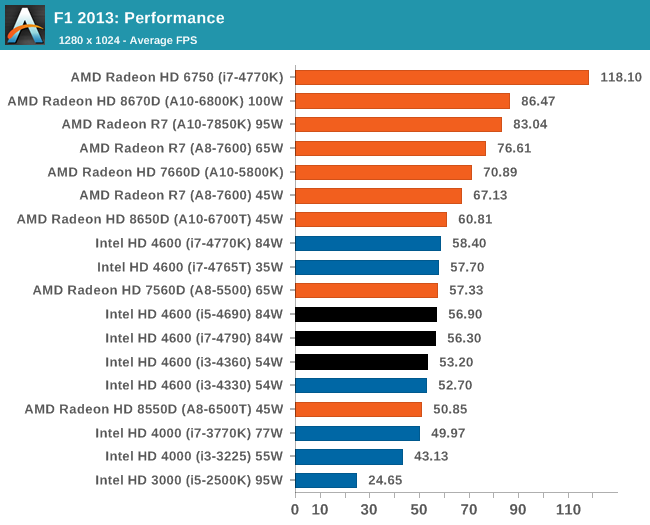
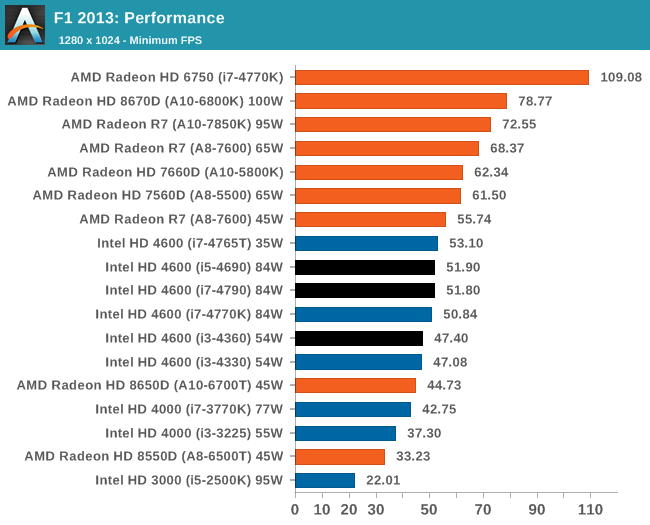
The HD 4600 at 1200 MHz falls just short of 60 FPS average on F1 2013, and moving up from the i3 seems to offer a 6% increase in minimum frame rates.
Bioshock Infinite

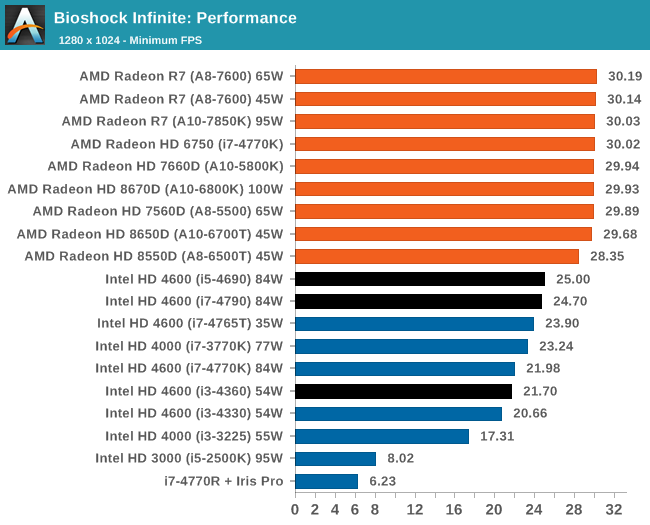
Bioshock Infinite seems memory bound a little, given how good Iris Pro is compared to the HD 4600 scores. There is almost a 10% jump from i3 to i5 here on average FPS and almost 20% in minimum FPS.
Tomb Raider
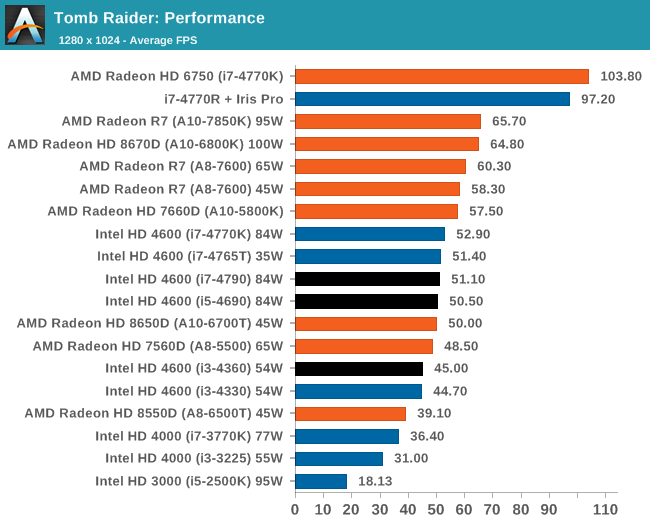
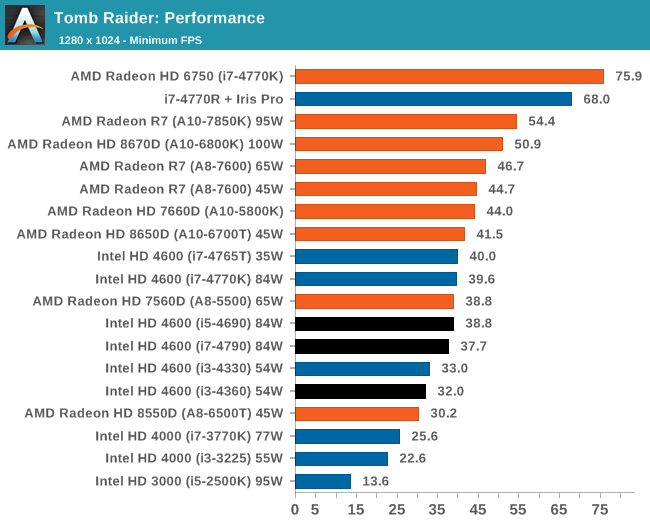
Tomb Raider with discrete GPUs is characteristally CPU agnostic, however moving from an i3 to an i5 gives and extra 5.5 FPS on average in our test.
Sleeping Dogs
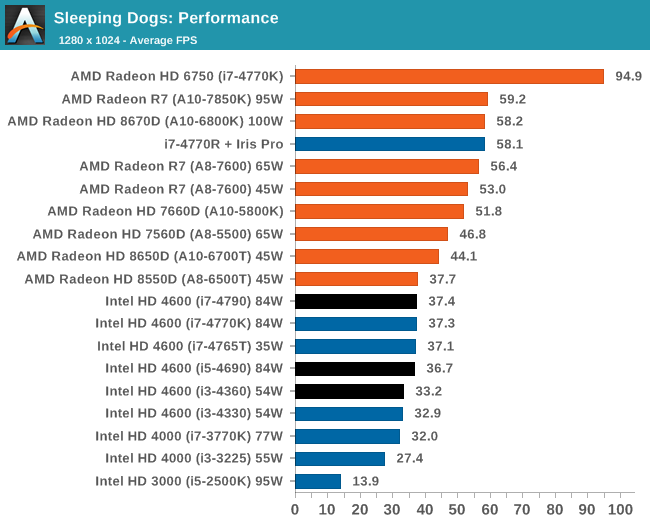

Company of Heroes 2

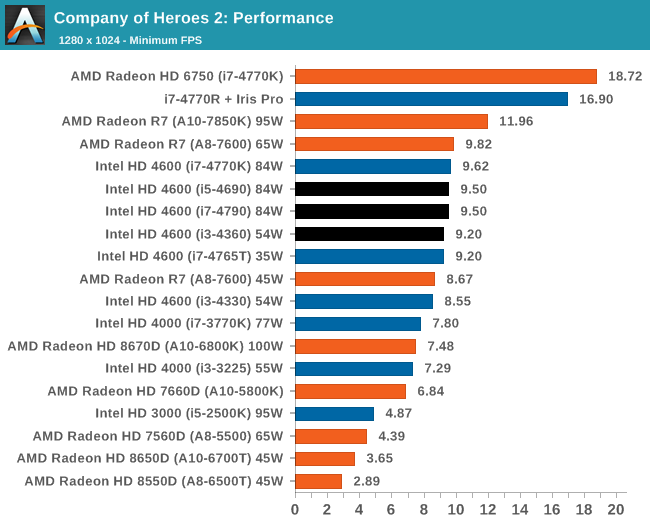
No IGP solution is that well prepared for COH2, although some AMD CPUs and Iris Pro do hit above 20 FPS. We may have to wait another generation to make it more playable and hit 30 FPS at our resolution settings.










130 Comments
View All Comments
Basilisk - Sunday, May 11, 2014 - link
While I enjoy the image of you chatting away with worms a'dangling, The Bard has his due:"Shall I bend low and in a bondman's key, With BATED breath and whispering humbleness, Say this..." [Shylock]. Billy originated the phrase, and his spelling is still considered correct... although it's a common enough error. Think of it as abated (restrained) breathing.
Informative article, however, so Thanks!
dwbogardus - Monday, May 12, 2014 - link
Really? I thought it meant breath that smelled like bait! (just kidding)coburn_c - Sunday, May 11, 2014 - link
I swear I saw a 'Death of the Desktop' and a 'PC gamers outnumber next-gen consoles' article in the same news feed last week.dave_the_nerd - Sunday, May 11, 2014 - link
So this is what you were working on?!?!10 days with no updates; you had me worried AnandTech. Thanks for the kickbutt review, as always.
davegraham - Sunday, May 11, 2014 - link
lol. in your conclusion, you say "baited breath" which would lead someone to believe that you smell of fish. what you meant to say is "bated breath" which approximates to your intent. :) great article overall Ian.IndyJaws - Monday, May 12, 2014 - link
Merchant of Venice +1FreeMan4096 - Sunday, May 11, 2014 - link
Impressive article. Bookmarking the webpage.Galatian - Sunday, May 11, 2014 - link
Ian: on page 12 dual 7970 testing in Bioshock Infinite the graph for minimum frame rates has the core i3 twice with two completely different values.Thanks anyway for the great article!
extide - Sunday, May 11, 2014 - link
"Eventually as the future of the chipset progresses, I see all these ports becoming flexible, though I would imagine we are a few years out from this." -- I actually don't think that will happen. It undoubtedly will increase the complexity of the chipset to allow the possibility for every single port to be configurable, thus increase costs. However, it is very unlikely that you would have a situation where you wouldn't want any SATA ports, or USB3 ports. Thus it seems pretty pointless to make ALL of the ports configurable. I would imagine that we will see a future with MORE configurability, but I would bet you will always see some dedicated ports.mapesdhs - Sunday, May 11, 2014 - link
If anyone's curious as to how the article's results compare to an oc'd older CPU,
here are some CB R15 numbers for a 5GHz i7 2700K (RAM @ 2133 CL10, ASUS M4E):
1-thread: 177
N-thread: 880
There's a power consumption difference of course, but the lower purchase cost of
a used 2700K makes up for it by more than an order of magnitude.
Ian.